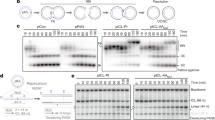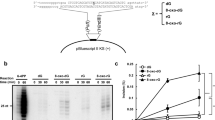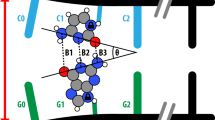Abstract
ONE of the major problems in the study of chemical carcinogenesis is to identify in cells or animals the nucleic acid adducts known from in vitro experiments. When normal or xeroderma pigmentosum (XP) human fibroblasts or fetal rat brain cells (FBC) in culture are treated with the carcinogen, ethylnitrosourea (EtNU), to an extent permitting good cell survival (2–5 ethyl groups per 100,000 bases), we find that the nature and proportion of the alkyl products in their DNA are remarkably similar to those found when DNA is alkylated with EtNU to a high extent in vitro (1 ethyl group per 100 bases). The products quantified in this study are ethylphosphotriesters, 7-ethylguanine (7-EtG), 3-ethyladenine (3-EtA), O6-ethyl-deoxyguanosine (O6-EtdGuo), O2-ethylthymidine (O2-EtThd), O4-ethylthymidine and O2-ethylcytosine (O2-EtC). We present here the first experimental evidence that pyrimidine oxygen atoms are major sites of reaction in cells treated with EtNU. A comparison of the present model experiments with purified DNA and poly(dG) · poly(dC) with earlier studies on single-stranded polynucleotides (refs 6, 10, Table 1) indicates that Watson–Crick base-pairing does not significantly hinder alkylation of the oxygens. This is in contrast to previous findings concerning the very low reactivity of base-paired nitrogens. We explain this on the basis that only the oxygens have a pair of electrons not directly involved in hydrogen bonding.
This is a preview of subscription content, access via your institution
Access options
Subscribe to this journal
Receive 51 print issues and online access
$199.00 per year
only $3.90 per issue
Buy this article
- Purchase on Springer Link
- Instant access to full article PDF
Prices may be subject to local taxes which are calculated during checkout
Similar content being viewed by others
References
Singer, B. Prog. Nucleic Acids Res. molec. Biol. 15, 219–284, 330–332 (1975).
Kleihues, P., Lantos, P. L. & Magee, P. N. Int. Rev. exp. Path. 15, 153–232 (1976).
Rajewsky, M. F. et al. Origins of Human Cancer, 709–726 (Cold Spring Harbor Laboratory, New York, 1977).
Pegg, A. E. Adv. Cancer Res. 25, 195–269 (1977).
Sun, L. & Singer, B. Biochemistry 14, 1795–1802 (1975).
Singer, B. Nature 264, 333–339 (1976).
Bannon, P. & Verly, W. Eur. J. Biochem. 31, 103–111 (1972).
O'Connor, P. J., Margison, G. P. & Craig, A. W. Biochem J. 145, 475–482 (1975).
Singer, B., Kröger, M. & Carrano, M. Biochemistry 17, 1246–1250 (1978).
Singer, B. J. Toxic. environ. Hlth 2, 1279–1295 (1977).
Stevens, C. L., Chay, T. R. & Loga, S. Biochemistry 16, 3727–3739 (1977).
Loveless, A. Nature 223, 206–207 (1969).
Gerchman, L. L. & Ludlum, D. B. Biochim. biophys. Acta 308, 310–316 (1973).
Singer, B., Fraenkel-Conrat, H. & Kusimerek, J. T. Proc. natn. Acad. Sci. U.S.A. 75, 1722–1726 (1978).
Miller, P. S., Fang, K. N., Kondo, N. S. & Ts'o, P. O. P. J. Am. chem. Soc. 93, 6657–6665 (1971).
Barrett, J. C., Miller, P. S. & Ts'o, P. O. P. Biochemistry 13, 4897–4906 (1974).
Miller, P. S., Braiterman, L. T. & Ts'o, P. O. P. Biochemistry 16, 1988–1996 (1977).
Bodell, W. J. & Banerjee, M. R. Nucleic Acids Res. 3, 1689–1701 (1976).
Author information
Authors and Affiliations
Rights and permissions
About this article
Cite this article
SINGER, B., BODELL, W., CLEAVER, J. et al. Oxygens in DNA are main targets for ethylnitrosourea in normal and xeroderma pigmentosum fibroblasts and fetal rat brain cells. Nature 276, 85–88 (1978). https://doi.org/10.1038/276085a0
Received:
Accepted:
Issue Date:
DOI: https://doi.org/10.1038/276085a0
This article is cited by
-
Quality control of chemically damaged RNA
Cellular and Molecular Life Sciences (2016)
-
After X-irradiation a transient arrest of L929 cells inG 2-phase coincides with a rapid elevation of the level of O6-alkylguanine-DNA alkyltransferase
Radiation and Environmental Biophysics (1991)
Comments
By submitting a comment you agree to abide by our Terms and Community Guidelines. If you find something abusive or that does not comply with our terms or guidelines please flag it as inappropriate.



